Äîêóìåíòàöèÿ è îïèñàíèÿ www.docs.chipfind.ru
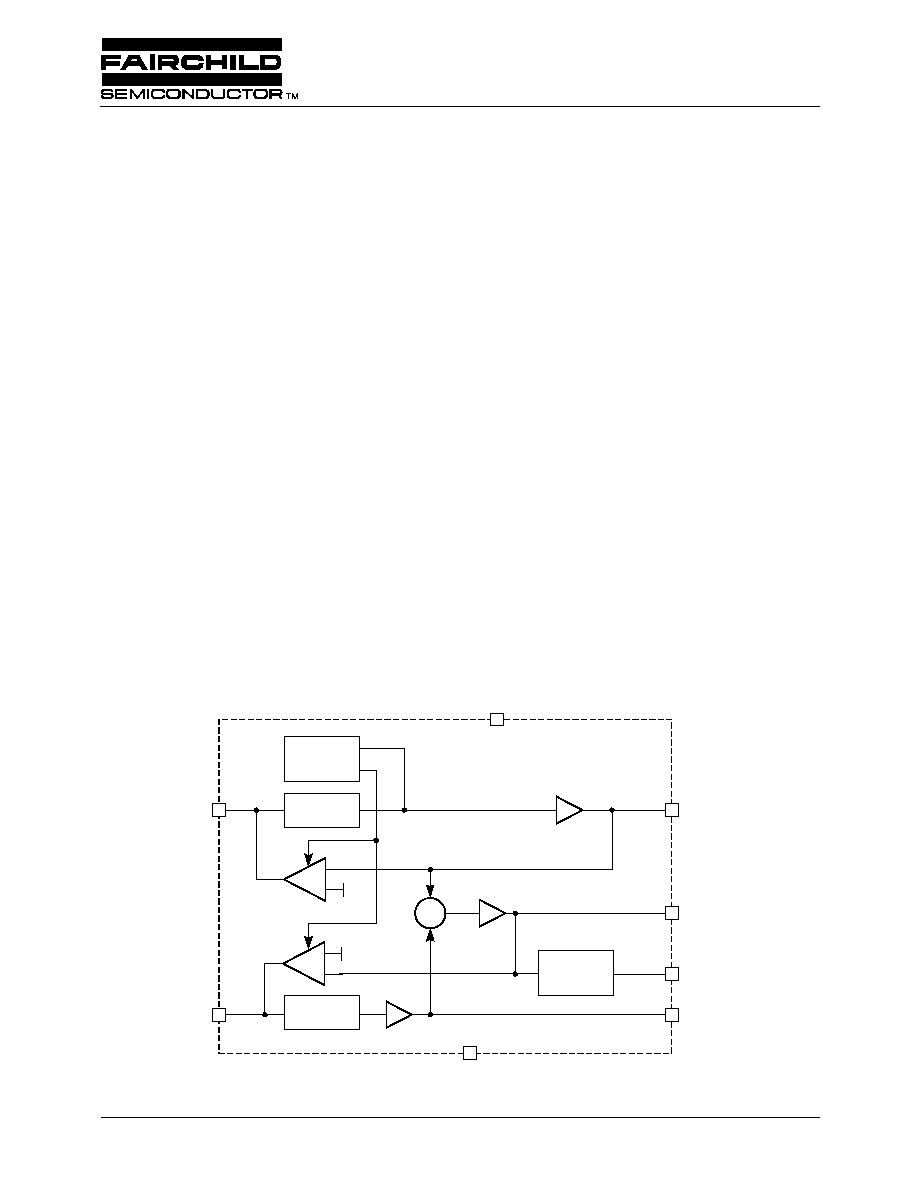
www.fairchildsemi.com
REV. 1.0.6 8/26/02
Features
· 7.1MHz Y and C filters, with CV out
· 14dB notch at 4.5MHz for sound trap
· 42dB stopband attenuation at 27MHz on Y, C, and CV
· Better than 1dB flatness to 4.5 MHz on Y, C, and CV
· RF Modulator output differential group delay between
400kHz and 3.58MHz is typically -170ns.
· No external frequency select components or clocks
· 9ns group delay flatness on Y, C, and CV output
· AC coupled inputs and outputs
· 0.4% differential gain on Y, C and CV channels, 0.4º
differential phase on Y, C and CV channels
· 0.8% total harmonic distortion on all channels
· DC restore with low tilt
Applications
· Cable Set-top Boxes
· Satellite Set-top Boxes
· DVD Players
General Description
The ML6416 is a dual Y/C 4th-order Butterworth lowpass
video filter optimized for minimum overshoot and flat group
delay. The device also contains a summing circuit to gener-
ate filtered composite video, an audio trap and group delay
compensation circuit to notch-out audio, providing an area
for the addition of the FM audio carrier(s) and mimic the
group delay distortion introduced at the transmitter. The
group delay predistortion compensates for the nominal TV
receiver IF filter distortion.
In a typical application, the Y and C input signals from
DACs are AC coupled into the filter. Both channels have DC
restore circuitry to clamp the DC input levels during video
sync. The Y and C channels use a separate feedback clamp.
The clamp pulse is derived from the Y channel.
The outputs are AC coupled. The Y, C, CV, and modulator
outputs can drive 2V
P-P
into a 150
load (1V
P-P
75
coax
load). The Y, C, CV, and notch channels have a gain of
approximately 2 (6dB) with 1V
P-P
input levels.
Block Diagram
CIN
4TH ORDER
FILTER
4
GND
3
YIN
VCC
1
7
YOUT
8
4TH ORDER
FILTER
+
+
NOTCH,
GROUP
DELAY
SYNC STRIP,
REFERENCE,
AND TIMING
RF MOD
2
COUT
5
CVOUT
6
1V
gM
1V
gM
×2
×2
×2
ML6416
S-Video Filter with Summed Composite Output,
Sound Trap, and Group Delay Compensation
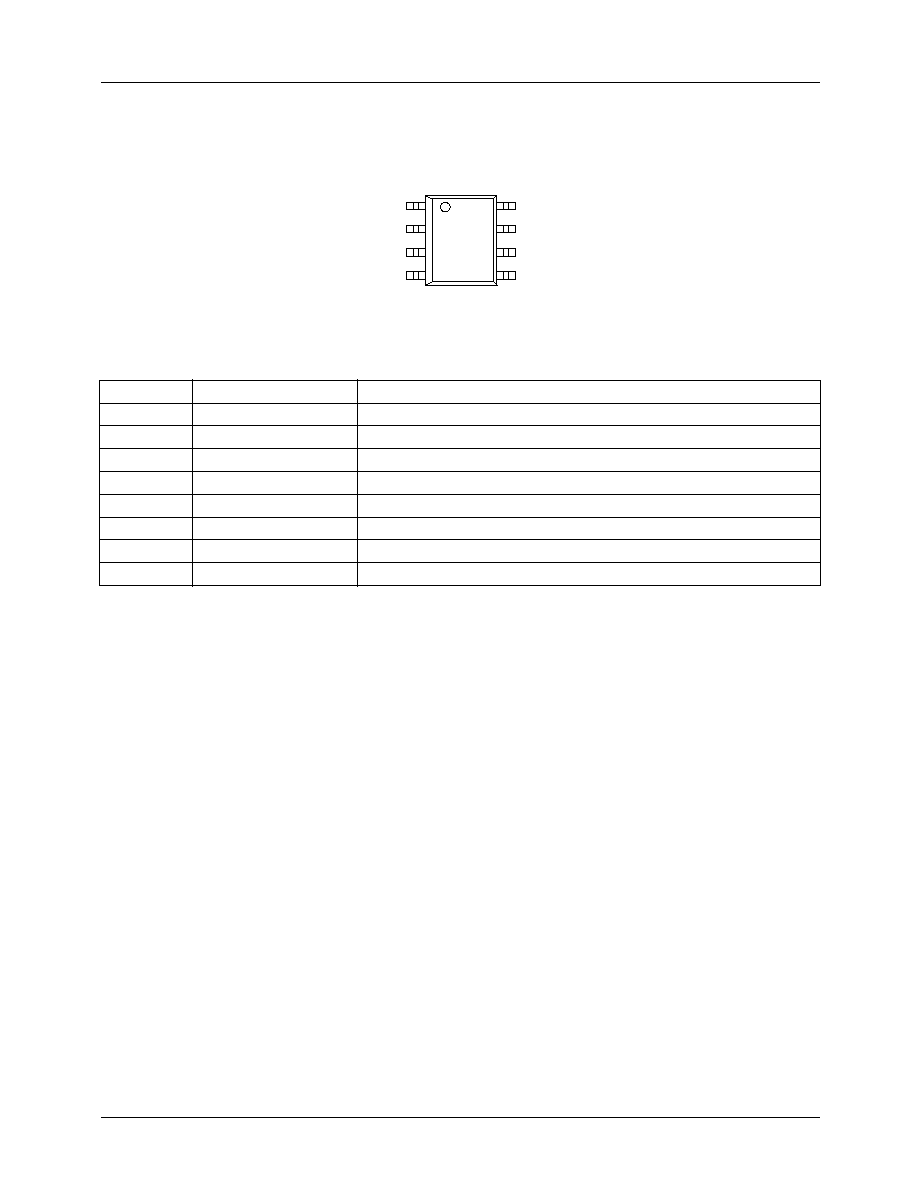
ML6416
PRODUCT SPECIFICATION
2
REV. 1.0.6 8/26/02
Pin Configuration
Pin Descriptions
Pin #
Signal Name
Description
1
YIN
Luminance input
2
RF MOD
Output to RF modulator driver
3
GND
Ground
4
CIN
Chrominance input
5
COUT
Chrominance output
6
CVOUT
Composite video output
7
VCC
5V supply
8
YOUT
Luminance output
ML6416
8-Pin SOIC (S08)
1
2
3
4
8
7
6
5
YIN
RF MOD
GND
CIN
YOUT
VCC
CVOUT
COUT
TOP VIEW
Functional Description
Introduction
This product is a dual monolithic continuous time video filter
designed for reconstructing the luminance and chrominance
signals from an S-Video D/A source. Composite video out-
put is generated by summing the Y and C outputs. The chip
is intended for use in applications with AC coupled input and
AC coupled outputs. (See Figure 1)
The reconstruction filters approximate a 4th-order Butter-
worth characteristic with an optimization toward low over-
shoot and flat group delay. Y, C, and CV outputs are capable
of driving 2V
P-P
into AC coupled 150
video loads, with up
to 35pF of load capacitance at the output pin.
All channels are clamped during sync to establish the appro-
priate output voltage swing range. Thus the input coupling
capacitors do not behave according to the conventional RC
time constant. Clamping for all channels settles to less than
10mv within 5ms of a change in video input sources.
In most applications the input coupling capacitors are 0.1µF.
The Y and C input typically sinks 1µA during active video,
which nominally tilts a horizontal line by about 2mV at the Y
output. During sync, the clamp typically sources 20µA to
restore the DC level. The net result is that the average input
current is zero.
Any change in the input coupling capacitor's value will
inversely alter the amount of tilt per line. Such a change will
also linearly affect the clamp response times.
This product is robust and stable under all stated load and
input conditions. Capacitive bypassing VCC directly to
ground ensures this performance.
Luminance (Y) I/O
The luma input is driven by either a low impedance source of
1V
P-P
or the output of a 75
terminated line. The input is
required to be AC coupled via a 0.1µF coupling capacitor
which allows for a settling time of 5ms. The luma output is
capable of driving an AC coupled 150
load at 2V
P-P
, or
1V
P-P
into a 75
load. Up to 35pF of load capacitance
(at the output pin) can be driven without stability or slew
issues. The output is AC coupled with a 220µF or larger AC
coupling capacitor.
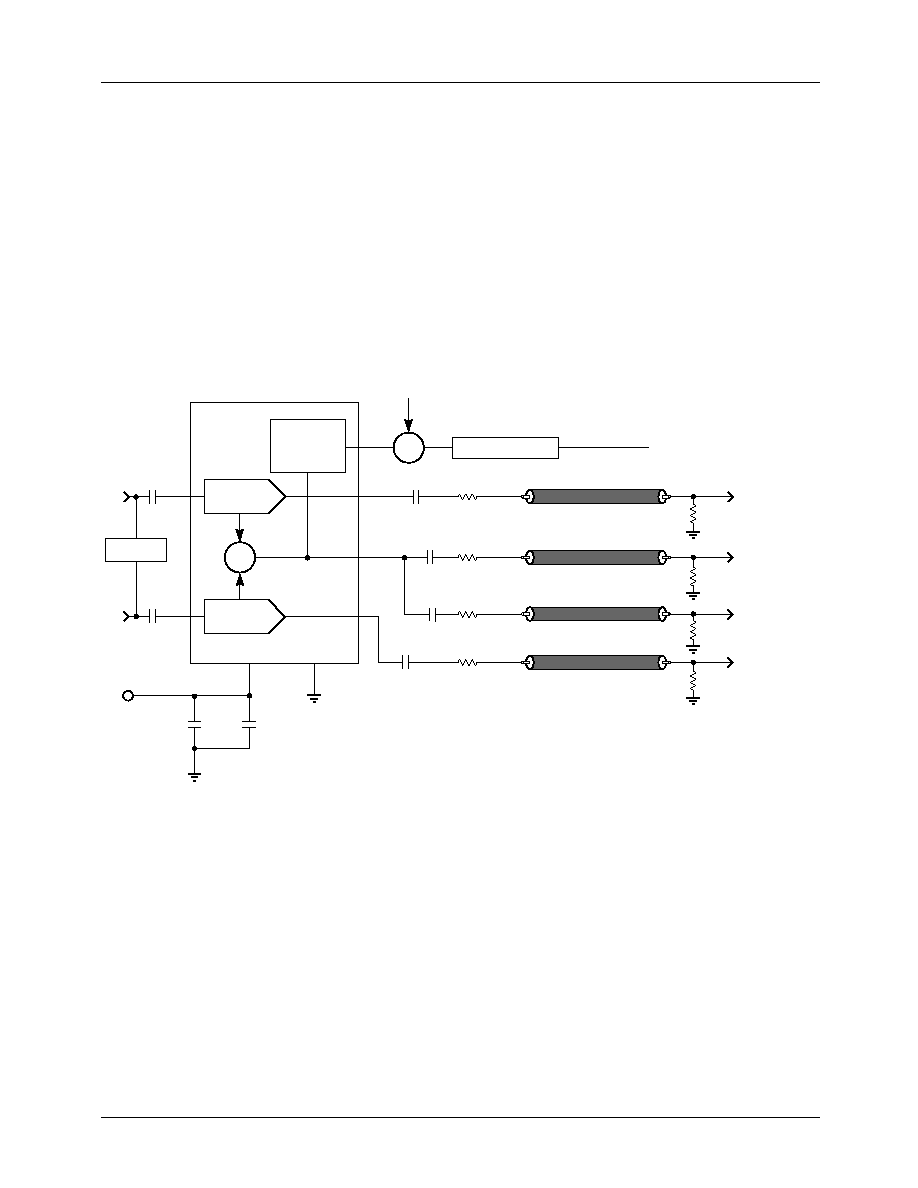
PRODUCT SPECIFICATION
ML6416
REV. 1.0.6 8/26/02
3
Chrominance (C) I/O
The chroma input is driven by a low impedance source of
0.7V
P-P
or the output of a 75
terminated line. The input is
required to be AC coupled via a 0.1µF coupling capacitor
which allows for a clamp setting time of 5ms. The chroma
output is capable of driving an AC coupled 150
load at
2V
P-P
, or 1V
P-P
into a 75
load. Up to 35pF of load capaci-
tance can be driven without stability or slew issues. A 0.1µF
AC coupling capacitor is recommended at the output.
(This reduces the circuit cost as chroma does not contain
low frequency components.)
Composite Video (CV) Output
The composite video output is capable of driving 2 loads to
2V
P-P
. It is intended to drive a TV and a VCR. Either the TV
input or the VCR input can be shorted to ground and the
other output will still meet specifications. Up to 35pF of load
capacitance (at the output pin) can be driven without stability
or slew issues.
RF Modulator Output
The RF modulator output is capable of driving a 600
load
to 2V
P-P
, but is primarily intended to drive a modulator load.
Typical Applications Diagram
Figure 1. Coupled S-Video, Composite Video Line Driver, Sound Trap, and Group Delay Pre-distortion
1
µF
0.1
µF
0.1
µF
0.1
µF
0.1
µF
220
µF
220
µF
VIDEO CABLES
75
75
75
75
75
75
75
YOUT
TO CHANNEL 3 OR 4
4.5MHz FM SOUND
TO TV
CVOUT TO VCR
COUT
YIN
CIN
5.0V
+
+
4th-ORDER
FILTER
1
4
8
2
5
3
7
6
NOTCH
AND GROUP
DELAY
PROTECTION
VIDEO MODULATOR
+
ENCODER
4th-ORDER
FILTER
220
µF
75
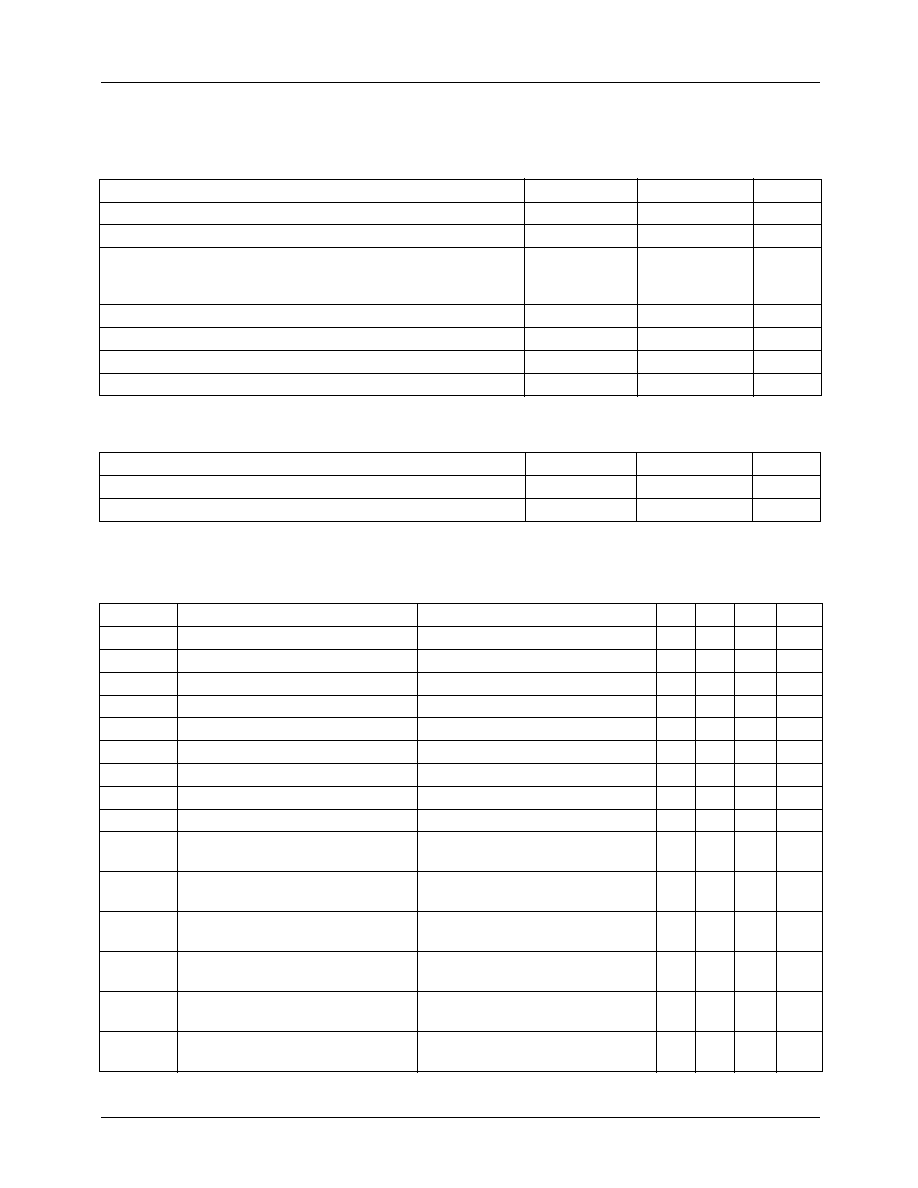
ML6416
PRODUCT SPECIFICATION
4
REV. 1.0.6 8/26/02
Absolute Maximum Ratings
Absolute maximum ratings are those values beyond which the device could be permanently damaged. Absolute maximum
ratings are stress ratings only and functional device operation is not implied.
Operating Conditions
Parameter
Min.
Max.
Units
DC Supply Voltage
0.3
7
V
Analog & Digital I/O
GND 0.3
V
CC
+ 0.3
V
Output Current (Continuous)
CV Channel
C and Y Channels
60
30
mA
mA
Junction Temperature
150
°C
Storage Temperature Range
65
150
°C
Lead Temperature (Soldering, 10s)
260
°C
Thermal Resistance (
JA
)
115
°C/W
Parameter
Min.
Max.
Units
Temperature Range
0
70
°C
V
CC
Range
4.5
5.5
V
Electrical Characteristics
Unless otherwise specified, V
CC
= 5.0V ±10%, All inputs AC coupled with 100nF, T
A
= Operating Temperature Range
Symbol
Parameter
Conditions
Min. Typ. Max. Units
I
CC
Supply Current
60
85
mA
V
CC
Supply Range
4.5
5.0
5.5
V
AV
YC
Low Frequency Gain (Y
OUT
, C
OUT
)
at 400KHz
5.75
6.0
6.25
dB
AV
RFMOD
Low Frequency Gain (RFMOD)
at 400KHz
6.1
6.7
7.3
dB
AV
CV
Low Frequency Gain (CV
OUT
)
at 400KHz
5.55
5.9
6.25
dB
C
OUT
Output Level (During Sync)
Sync Present on Y
IN
1.6
2.0
2.4
V
Y
OUT
Output Level (During Sync)
Sync Present on Y
IN
0.75
1.0
1.25
V
CV
OUT
Output Level (During Sync)
Sync Present on Y
IN
0.75
1.0
1.25
V
RFMOD Output Level (During Sync) Sync Present on Y
IN
0.65
1.0
1.35
V
tCLAMP
Clamp Response Time (Y Channel)
Settled to Within 10mV, 0.1µF cap
on Y
IN
and C
IN
5
9
ms
f
1dB
1.0dB Bandwidth (Flatness)
(Y
OUT
, C
OUT
, and CV
OUT
)
No Peaking Cap (Note 1)
4.2
4.5
MHz
f
C
3dB Bandwidth (Flatness)
(Y
OUT
, C
OUT
, and CV
OUT
)
6.7
7.1
MHz
f
SB
Stopband Rejection (Y
OUT
, C
OUT
,
and CV
OUT
)
f
IN
= 27MHz
-37
42
dB
V
i
Input Signal Dynamic Range
(All Channels)
AC Coupled
1.2
1.4
V
P-P
I
SC
Output Short Circuit Current
(All Channels)
C
OUT
, Y
OUT
, CV
OUT
, RFMOD to
GND (Note 2)
40
80
mA
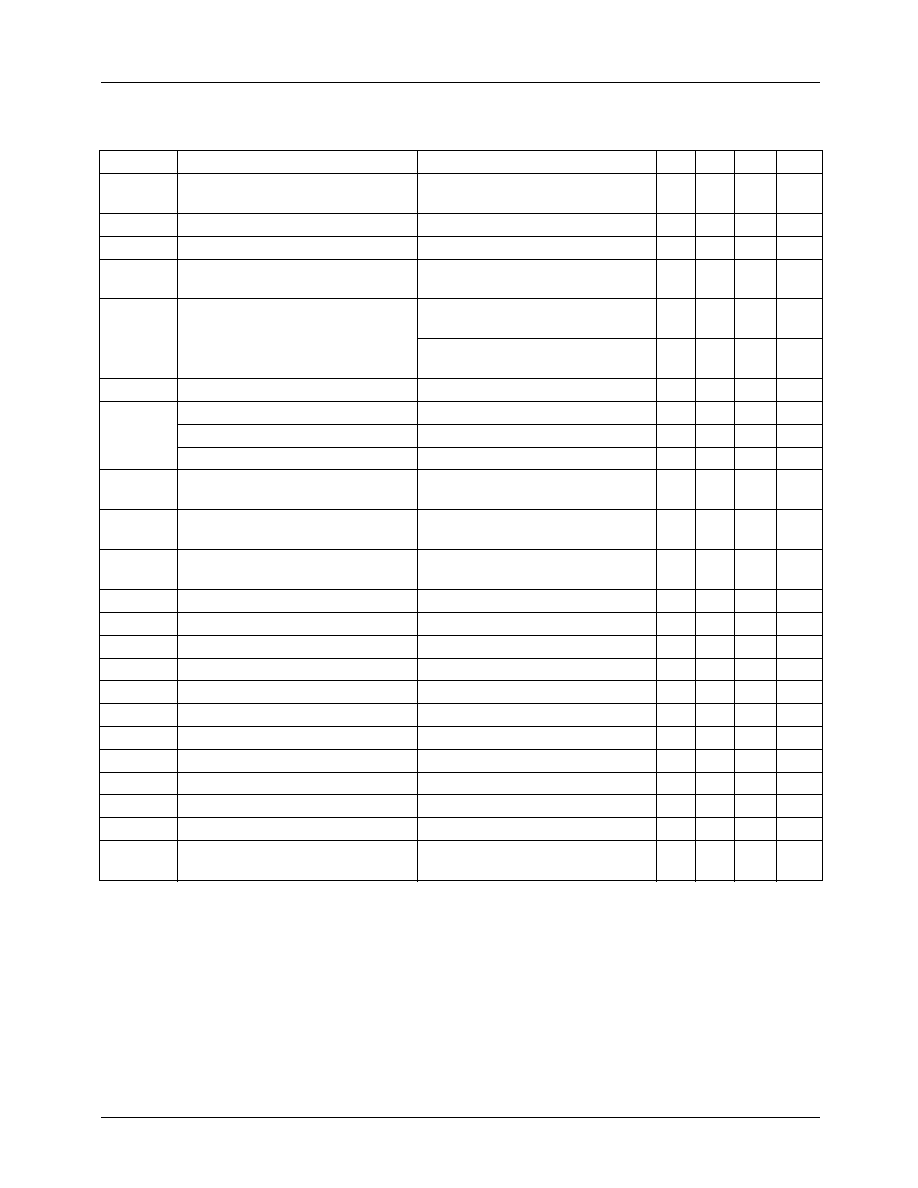
PRODUCT SPECIFICATION
ML6416
REV. 1.0.6 8/26/02
5
Notes
1. Peaking capacitor increases CV output at 4.2MHz nominally by 0.7dB
2. Sustained short circuit protection limited to 10 seconds
3. Referenced to 400kHz
4. Group Delay is tested down to 400kHz but guaranteed by design to 200kHz.
5. Guaranteed by characterization
CL
Output Shunt Capacitance (All
Channels) (Note 5)
All Outputs
35
pF
dG
Differential Gain (Note 5)
Y
OUT
, C
OUT
, and CV
OUT
0.4
1
%
dP
Differential Phase (Note 5)
Y
OUT
, C
OUT
, and CV
OUT
0.4
1
°
THD
Output Distortion (All Channels)
(Note 5)
VOUT = 1.8V
P-P
, Y/C Out at
3.58MHz
0.8
1.0
%
XTALK
Crosstalk (Note 5)
From C
IN
of 0.5V
P-P
at
3.58MHz to Y
OUT
-45
-55
dB
From Y
IN
Input of 0.4V
P-P
at
3.58MHz, to C
OUT
-50
-58
dB
PSRR
PSRR (All Channels) (Note 5)
0.5V
P-P
(100KHz) at VCC
-30
-40
dB
SNR
Y, C Channel (Note 5)
NTC-7 weighting 4.2 MHz lowpass
-65
-75
dB
CV Channel (Note 5)
NTC-7 weighting 4.2 MHz lowpass
-60
-70
dB
RFMOD Channel (Note 5)
NTC-7 weighting 4.2 MHz lowpass
-55
-65
dB
tpd
Propagation Delay (Y, C, CV)
(Note 5)
30
70
110
ns
tpd
Group Delay Deviation from Flatness
(Y, C, and CV) (Note 5)
to 3.58MHz (NTSC)
9
ns
tSKEW
Skew Between Y
OUT
and C
OUT
(Note 5)
at 1MHz
0
ns
T
CLDCV
Chroma-Luma Delay C
VOUT
f = 3.58 MHz (referenced to 400kHz) -35
0
35
ns
T
CLGCV
Chroma-Luma Gain C
VOUT
f = 3.58 MHz (referenced to 400kHz)
92
95
104
%
GD
MOD
Group Delay RFMOD
f = 3.58MHz (referenced to 400kHz) -205 -170 -135
ns
T
CLDMOD
Chroma-Luminance Delay RFMOD
f = 3.58MHz (referenced to 400kHz) -185 -150 -115
ns
T
CLGMOD
Chroma-Luminance Gain RFMOD
f = 3.58MHz (referenced to 400kHz)
95
100
105
%
dG
RFMOD
Differential Gain
RFMOD Channel
1.5
4
%
dP
RFMOD
Differential Phase
RFMOD Channel
1.0
1.5
°
pK
Gain Peaking (Note 3)
RFMOD Channel at 2.0MHz
0.5
0.75
dB
MCF
Modulator Channel Flatness (Note 3) at 3.75MHz
-0.5
-0.1 +0.75
dB
AV
Notch Attenuation (Note 3)
From 4.425MHz to 4.63MHz
14
dB
AV
Notch Attenuation (Note 3)
At 4.2MHz
5
dB
T
PASS
Passband Group Delay, RFMOD
(Note 4)
f = 200kHz to f = 3MHz
-50
50
ns
Electrical Characteristics
(continued)
Unless otherwise specified, V
CC
= 5.0V ±10%, All inputs AC coupled with 100nF, T
A
= Operating Temperature Range
Symbol
Parameter
Conditions
Min. Typ. Max. Units




